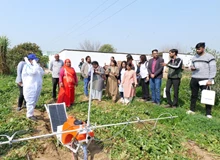
Bird flu, also known as Avian Influenza, is a highly contagious viral infection that primarily affects birds. While most strains of Bird Flu do not infect humans, certain variants, such as H5N1 and H7N9, have caused severe illness and even death in people who have come into close contact with infected birds. The potential for these viruses to mutate and spread among humans is a significant concern, making effective communication and information dissemination crucial in preventing outbreaks. Additionally, the spread of misinformation regarding Bird Flu has become a significant concern. Therefore, this explainer aims to provide a comprehensive guide on how to combat bird flu misinformation effectively.
During an interaction with Krishi Jagran, Dr. Rukhsana Parveen, Professor Department of Pathology at Bangladesh Agriculture University (BHU) said, “I have been researching about Avian Influenza virus since 2007, there is myth or superstitions, especially in Southeast East Asian countries that if people eat egg or chicken, they may suffer from Bird Flu. Such is completely wrong, rather I would say, the cooking process in our country facilitates complete boiling and kills almost all microorganisms. The Bird Flu virus is transmitted due to the following causes:
-
If a person touches a Bird Flu-affected bird and immediately after touches their nose, face, or mouth.
-
If the virus is inhaled from droplets or dust in the air, especially, when the bird flu-affected bird is transported to the live bird market for sale. The aerosols, during that time, are inhaled by humans. So, the people working in the bird flu-affected poultry farm or transporting must wear protective clothing, goggles, masks, and gloves while killing or disposing of affected birds.
Lastly, there is no restriction to eating eggs or chicken. It is a valuable and cheap source of protein.”
How To Spread Awareness
-
Develop educational materials that explain the basics of bird flu transmission, symptoms, and preventive measures in simple, accessible language. Include illustrations and infographics to enhance understanding.
-
Distribute these materials through multiple channels, including social media, community centers, schools, and healthcare facilities. Collaborate with local influencers and celebrities to amplify the reach of educational messages.
-
Partner with local organizations, government agencies, and healthcare providers to host workshops, seminars, and informational sessions on bird flu prevention and control.
Consider Fact-Checking and Verification
-
Establish a dedicated team or platform for monitoring and debunking misinformation related to bird flu. Train team members in critical thinking, research methodologies, and fact-checking techniques.
-
Use reliable sources such as the World Health Organization (WHO), Centers for Disease Control and Prevention (CDC), and reputable scientific journals to verify information before sharing it with the public. Provide citations and references to support factual claims.
-
Encourage individuals to fact-check information before sharing it on social media or other platforms. Promote the use of fact-checking websites and tools to verify the accuracy of news articles and social media posts.
Maintain Transparent Communication
-
Provide regular updates on the status of Bird Flu outbreaks, including confirmed cases, containment efforts, and preventive measures. Use clear and concise language to convey complex information to the public.
-
Be transparent about uncertainties and limitations in scientific knowledge, while emphasizing the importance of following evidence-based guidelines. Acknowledge any mistakes or errors in previous communications and provide corrected information as needed.
-
Engage with the public through town hall meetings, press conferences, and online forums to address concerns and answer questions directly. Encourage feedback and dialogue to foster trust and credibility.
Participate In Community Engagement
-
Foster partnerships with local communities, including poultry farmers, healthcare workers, and religious leaders, to build trust and facilitate open dialogue. Respect cultural norms and traditions when communicating with diverse communities.
-
Tailor communication strategies to address cultural beliefs, language barriers, and specific needs within diverse communities. Provide translated materials and interpreters as needed to ensure accessibility.
-
Empower community leaders to serve as trusted sources of information and advocates for preventive measures. Deliver training and resources to community influencers to help them effectively communicate key messages to their networks.
Empower Healthcare Professionals
-
Provide training and resources to healthcare professionals on identifying Bird Flu symptoms, conducting risk assessments, and communicating effectively with patients and the public. Offer continuing education opportunities to keep healthcare providers updated on the latest developments in Bird Flu prevention and control.
-
Encourage healthcare providers to actively address misinformation during patient consultations and to refer individuals to reliable sources for accurate information. Provide them with fact sheets, brochures, and other materials to share with patients and their families.
-
Collaborate with professional organizations and regulatory bodies to develop guidelines and protocols for healthcare professionals dealing with Bird Flu cases. Ensure that healthcare facilities have access to necessary resources, such as personal protective equipment (PPE) and diagnostic tests, to effectively manage outbreaks.
Leverage Technology for Apt Information
-
Utilize digital tools such as mobile apps, chatbots, and interactive websites to deliver timely information and answer frequently asked questions. Develop user-friendly interfaces that are accessible to people of all ages and literacy levels.
-
Monitor social media platforms and online forums for misinformation trends, and respond promptly with accurate information and corrective messaging. Use data analytics and sentiment analysis tools to identify key influencers and target misinformation hotspots.
-
Collaborate with tech companies to develop algorithms that prioritize trustworthy sources and flag potentially misleading content. Work with social media platforms to implement fact-checking labels and warnings for posts containing false or misleading information.
Together, we can ensure that accurate information prevails over fear and uncertainty, safeguarding both human and animal populations from the impacts of this infectious disease.










